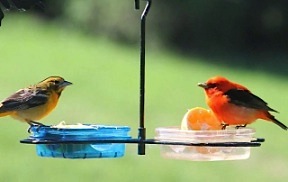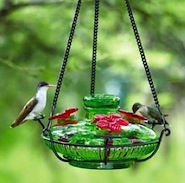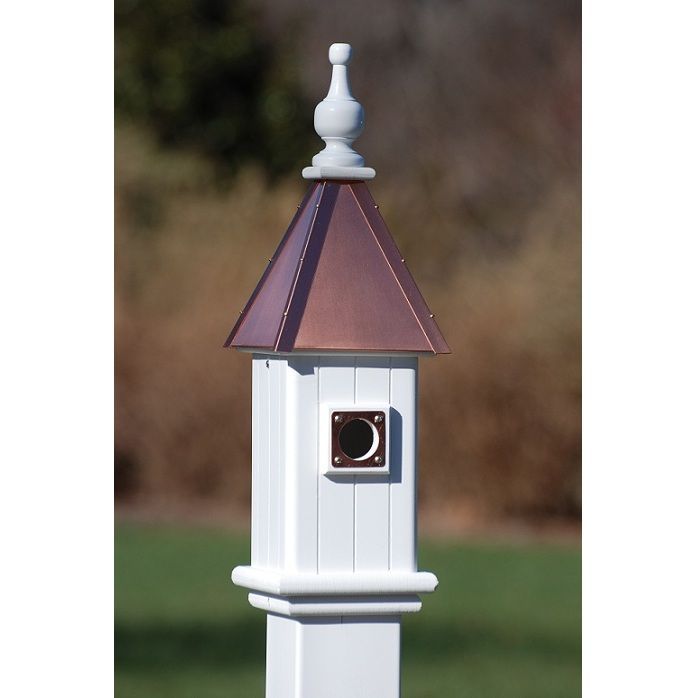- Bird Feeders, Fruit Bird Feeder, Fruit, Jelly & Mealworm Feeders, Live Meal Worms, Mealworm Feeder, Uncategorized
live worms escaping your mealworm feeder?
A customer’s question grabbed our attention: “How do you keep the worms inside the mealworm feeder?”
Tooth, texture… that’s what it’s all about here. If the surface of the feeder is not smooth as glass, the wiggly, crawly delights get hold and simply crawl right out! Now this is a huge advantage to ground feeding birds like robins – ours actually sit and wait below the mealworm feeder. But for bluebirds, chickadees, nuthatches, warblers, swallows and titmice, they have to swoop down to catch their worms if they’ve all crawled out.
So what’s the point of using a hanging dish feeder if worms end up on the ground? Not much! If you’re feeding live worms, it’s best to use a feeder that has absolutely no texture on the inside surface. Worms will stay put longer, and while juveniles are learning to use feeders, this is helpful.
An open dish type feeder will also accommodate a good variety of other treats to entice wild birds. Oranges used in this double-dish model have orioles flocking and teaching babies where the good stuff is! Suet chunks and peanuts are also good options for winter feeding.
Smooth, plexi-glass meal worm feeders like this are available in staked, hanging and even pole-mounted options. They’re durable for year-round use and dishwasher safe. Birds can perch anywhere on the dish – making it easier to land and feed. The vertical hangers are long enough to use with a weather guard, or even a baffle should squirrels be a problem around your place.
If you’re on the squeamish side and can’t bear the thought of live worms, birds will also go for dried worms. In fact they pack more protein per serving! Consider a dish style mealworm feeder this season… they work great for more than just worms!
-
Hummingbird Feeders and Audubon’s Newest Citizen Science Project
A recent discussion on the absence of usual numbers of tiny sprites at nectar feeders concluded with several possible scenarios. So today when this email (and plea for help with a new citizen science project) from Audubon was opened… we thought it quite pertinent to what was recently concluded on the declining numbers of these magical birds at backyard hummingbird feeders.
From Audubon:
A Rufous Hummingbird weighs less than a french fry and can fly 1,000 miles without food or rest. They may be mighty mites, but there’s one challenge they may not be able to overcome: us.National Audubon Society scientists estimate that the global population of these amazing flyers has declined nearly 60 percent in the past three decades.
What’s pushing hummingbirds toward the brink? A deadly combination of habitat destruction, toxic pollution and the spread of invasive plants. And now a new threat may overshadow them all: ecological chaos caused by a warming climate. Warmer weather prompts earlier flowering of nectar-bearing plants that hummingbirds rely on during their epic migrations. If the flowers are gone before the birds arrive, they may starve.The Rufous Hummingbird was common when we were kids. But it’s just one of dozens of familiar bird species headed for trouble.
Audubon has always been at the forefront of protecting birds and their habitats. And as threats have grown, so have the breadth and sophistication of our conservation strategies.
Hummingbirds at Home
This spring, Audubon united cyberspace with a century of citizen science experience to launch a high-tech tracking project called Hummingbirds at Home. Participants can download a mobile app or access a website to report sightings of hummingbirds nationwide. Using the data, our scientists will map conservation strategies to protect these birds’ future.Hummingbirds at Home is just one of the 21st Century approaches we are taking to secure a future for birds and their habitat. We’re also using Big Data analytics to find hidden patterns in a century of Christmas Bird Count stats. We’re using social media to organize and rally support for bird-friendly laws. And we’re using the web to foster a new generation of bird-lovers who will carry on our conservation work.
Will our children and grandchildren grow up with the wonder of watching a hummingbird hover over the flowerbed or sip nectar from a backyard feeder?
With your help, they will. Please donate today and your gift will go twice as far to protect birds.
Help us save hummingbirds, other birds and their habitats with a generous summer donation to Audubon. And, from now until July 25, your donation will be matched dollar for dollar, up to a total of $200,000! -
Attracting the right birds takes research (pertaining to bluebird houses)
This letter to the editor appeared in The Journal Gazette, Fort Wayne, IN., a few days ago. We thought it might be of interest to those who are newer to backyard birding and so fascinated with all their feathered visitors. Because all songs are not always good ones, we believed this post was in order, especially when adding bluebird houses around your yard.
“Attracting the right birds takes research, effort
Eight years ago, when my husband and I moved to the Spencerville-Leo country area, I decided to put out a birdhouse. Soon our birdhouse was occupied by a pair of bluebirds and five blue eggs. I thought how easy and why was attracting bluebirds thought to be such a hard task? Unfortunately, I discovered the answer. The main problems for bluebirds are house sparrows.
House sparrows are extremely destructive to American species of birds. House sparrows make a point of taking over nesting sites. Sparrows often and viciously take over nesting boxes inhabited by our American species. They trap adult birds in their nesting boxes and kill adult birds by pecking the skulls. Sadly, sparrows most notoriously attack the baby birds also. Sadly, in one summer I have lost as many as 11 bluebirds, mostly attributable to the sparrow and another non-native American bird, the starling.
If you are thinking about feeding birds or housing birds in your backyard, please be aware of what types of birds you bring into your area. Monitor your nesting boxes often to make sure you are attracting the birds you desire.
Now I feel like I’m starting over attracting bluebirds, but they are well worth the effort. As for my personal opinion toward house sparrows, they are nothing but trouble.
LAURA McCANN Spencerville”
Not all sparrows are bad, so it’s best to familiarize yourself with their identification by their song and plumage. Simply do a search for the ill-willed, non-native bird, and images with tons of resources will appear. Note the differences in male, female and juvenile birds as well. If you are serious about attracting bluebirds to your place, this information will serve you and the birds very well!



